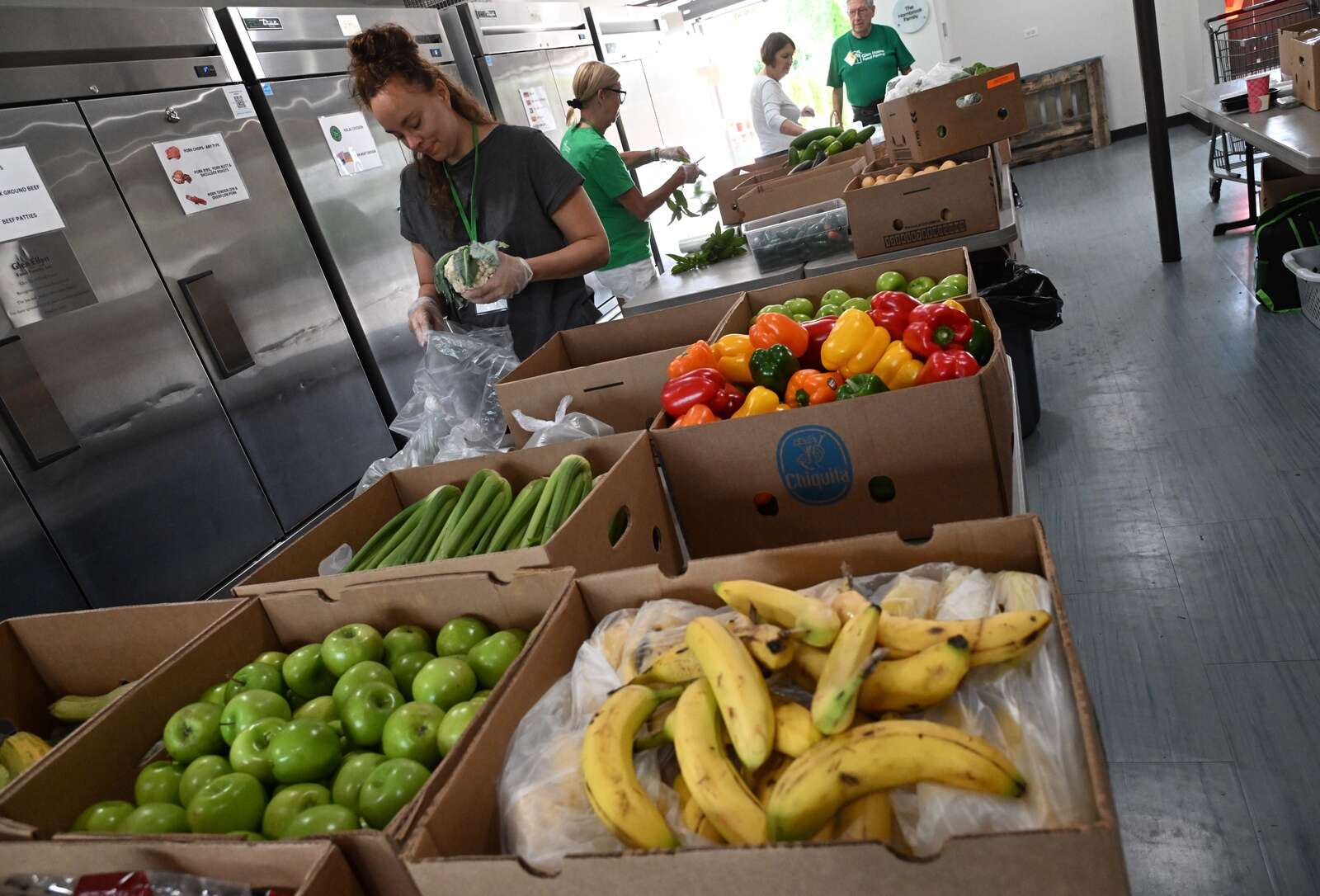The Glen House Food Pantry has a brass plaque inscribed with a Gaelic greeting, roughly translated as “a hundred thousand welcomes.”
It was a prescient sign from the original home-turned-pantry in Glen Ellyn. Since the start of the year, the pantry has welcomed 367 new households for shopping services.
“We’ve been adding an extra shift on Thursday nights because we can’t keep up with demand,” says Laura Glaza, the executive director.
As its member pantries face persistently high demand, the Northern Illinois Food Bank is raising funds through an emergency initiative to help offset federal cuts.
Glen House Food Pantry volunteer Brianna Gorham bags cauliflower for clients in Glen Ellyn.
Paul Valade/[email protected]
The Geneva-based food bank has seen a 30% decrease in federal support — in the form of food and funding — translating to a $3 million to $4 million gap. In the fiscal year that ended in June, the food bank received 4.4 million meals through federal programs that have either been discontinued or cut by the USDA.
“Quite frankly, we’re doing everything we can, but that’s a very large gap for us to fill,” said Julie Yurko, the food bank’s president and CEO. “We distributed just over 93.5 million meals last year, and so to have to replace 4 to 5 million of those, that’s tough.”
What’s more, the food bank warned in July that the overhaul to the Supplemental Nutrition Assistance Program, or SNAP — including new work requirements, cost-shifting to states and limits on benefit adjustments — will “significantly reduce access to food assistance and increase demand on charitable food systems already stretched thin.”
‘We will be here’
There are more than 900 pantries, soup kitchens, shelters and other feeding programs in the food bank’s distribution network across 13 counties, including DuPage, Kane, Lake, McHenry and Will.
The food bank launched a Community Response Fund to help fill the gap and “help us plan within the uncertainty,” Yurko said.
“We are heartbroken over the cuts to SNAP benefits,” she said. “The SNAP food stamp program is an empowering program. It’s a program that provides families with a resource to get food and have the dignity of going and purchasing the food that they need for their families,” Yurko said. “And we know it works. It works, and it’s able to grow in times of pandemic, and it’s able to contract when need is less.”
Volunteers sort potatoes at the Northern Illinois Food Bank in Geneva in July.
John Starks/[email protected]
SNAP benefits went down to pre-pandemic levels in 2023. Between that February and March, the food bank saw 100,000 more people come to its network.
“Is it a little bit heavier right now? Yes, it is,” Yurko said. “Have we been through heavy before? We have. But we will be here. And I believe in the goodness of people and community, and I believe we all rise to this. I have to.”
The nonprofit has a team dedicated to sourcing food.
“We are trying to be aggressive and making sure people know about us,” Yurko said, “that food donors, farmers, manufacturers, that they know about us.”
The organization also plans to purchase between $14 million and $18 million worth of food this year.
What pantries are feeling
The Schaumburg Township Food Pantry served 14,781 families last fiscal year. About 31% of its households have self-reported that they’re SNAP recipients, said Diana Nelson, who oversees the pantry within the Greater Chicago Food Depository network.
“SNAP is just one more obstacle, but we’ve already been trying to figure out other ways that we can get more donations and have additional support from the community and have more in our pantry,” she said.
There’s been an average 8% increase in the number of households that use the pantry in the first eight months of this fiscal year. The township’s casework team sees “a lot of underemployment,” Nelson said.
“The community that we live in — cost of living, rent, transportation — all of those factors, they’re high,” she said. “And so it is difficult to manage when you are even a one- or two-family household with income.”
Every week, the Aurora Interfaith Food Pantry feeds, on average, about 1,500 families, Executive Director Katie Arko said. It’s promoting a monthly donor program this Hunger Action Month and spotlighting food insecurity.
“In the last year, I think it’s tightened up,” she said of the job market. “And I think that has caused some people to find themselves needing to visit our pantry. And I definitely think inflation is still a factor.”
There are certain items that pantry staff and volunteers “get very excited about,” including eggs, she said.
The Glen House Food Pantry, as its name suggests, operates out of a former Craftsman-style house and opens the door to anyone in need who lives, works or attends school in DuPage County.
“We’re in a house, and that sets us apart from most other food pantries,” says Laura Glaza, executive director of the Glen House Food Pantry, which is based in a renovated church parsonage close to Roosevelt Road.
Paul Valade/[email protected]
“Our clients are seeing that, which is why they’re coming here,” Glaza said of inflation. “But now we’re seeing that because we have to shop at the grocery store, too. So it’s a Catch-22 kind of situation.”
The pantry distributed 455,000 pounds of food in the first six months of the year — compared to 420,000 in the first half of 2024. Roughly half is distributed through a grocery-style space in the former church parsonage next to Faith Lutheran. The other half is provided outside the pantry through community partners. The Kiwanis, for instance, assemble 700 packs of nutritious snacks a week that are distributed through school social workers to children for over the weekends when they have no access to free meals at school.
Fresh produce from area gardens helps support the Glen House Food Pantry in Glen Ellyn.
Paul Valade/[email protected]
Clients can walk in without an appointment once a week. They can make an appointment once a month when they can receive fresh fruits and vegetables, baked goods and nonperishable items, plus a more robust selection of meat, dairy, personal care items as well as household goods. The pantry used to handle about 20 appointments in a two-hour period.
“Now we’re squeezing in 32 and sometimes 35. It means people have to shop a little faster, which we don’t like,” Glaza said.
Glen House Food Pantry staff member Donna Blake moves a cart of melons for clients in Glen Ellyn.
Paul Valade/[email protected]
To accommodate the need and address rising food costs and declining availability of free or reduced-price groceries, the board this spring increased its monthly budget for purchases from the food bank and local retailers to $20,000. But in July alone, the pantry spent $28,000 — a record, Glaza said.
“And now the board feels we will do whatever it takes to feed people.”
Here is a sampling of events supporting the Glen House Food Pantry during September, designated as Hunger Action Month.
• A volunteer orientation and pantry tour will be held 5:30-6:30 p.m. Sept. 24. To register, visit glenhousefoodpantry.org.
• Donate through the pantry’s virtual food drive on Amazon
• For a full list of community food drives, visit glenhousefoodpantry.org.

Gerald Steele is the founder of Stonegate Health Rehab. He shares expert insights, recovery tips, and rehab resources to support individuals on their journey to wellness.
